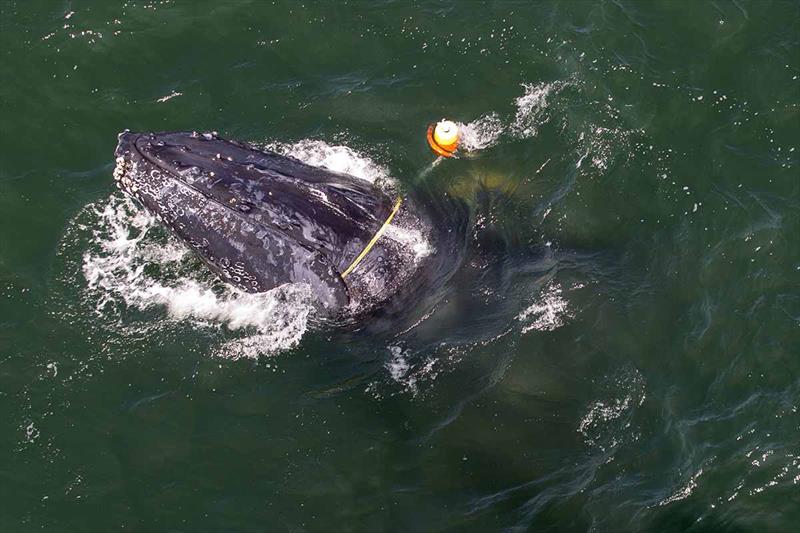
Whale entanglement causes and solutions detailed in new report
by NOAA Fisheries 9 Nov 2018 10:05 UTC

A humpback whale entangled in fishing gear surfaces for air about two miles off Crescent City, California. Disentanglement teams working with local fishermen and others freed the whale on Tuesday July 19, 2017 © Bryant Anderson / NOAA Fisheries, NOAA Fisheries MMHSRP Permit# 18786-01
Whale entanglements off the West Coast and potential solutions to the escalating problem are the focus of a new report including the presentations and observations of fishermen, biologists, and fisheries managers who gathered at an August workshop on the subject.
In recent years, growing populations of humpback and gray whales, changing ocean conditions and prey locations, and later crab season openings have led to more whales becoming entangled in fishing gear, such as the ropes and floats that mark the location of crab pots. In 2017 there were 31 confirmed entanglements off the West Coast. While these entanglements are still proportionally rare, they sometimes lead to the deaths of entangled whales, so both fishermen and fisheries managers are seeking solutions.
To understand how and where rope and other gear entangles whales and to find ways to address the problem, the Pacific States Marine Fisheries Commission (PSMFC) and NOAA Fisheries' West Coast Region convened a two-day workshop in Long Beach, California, in August. This "forensic workshop" was also supported by The Marine Mammal Commission, Oregon Sea Grant, and the Aquarium of the Pacific. The report from the workshop is now available.
The report provides the notes and presentations from the 31 California, Oregon, and Washington experts who attended. Participating were Dungeness crab fishermen; gear specialists; marine mammal biologists and disentanglement specialists; conservation groups; and federal, tribal, and state agency representatives.
Participants reviewed the best practices documents each state has developed in light of forensic review information presented, discussed possible improvements in gear marking that would help better identify entangling gear, and discussed potential gear modifications or research that might help reduce the number of entanglements.
NOAA Fisheries' Dan Lawson explained that, "Though the workshop did not seek consensus from the participants, there were a number of things that seemed to have broad participant support." For example, there was strong support for establishing a repository where gear removed from entangled whales could be stored after evaluation. "Fishermen really wanted to continue to engage with the whale experts on this forensic review work. They saw real value in this," he said.
Other actions that could help minimize whale entanglements were discussed, including:
- improving gear markings, and coordination between the states, to better identify the origins of gear involved in entanglements;
- exploring alternative ways to connect buoys and lines on the gear to minimize the use of knots and splices, especially on upper portions of gear where entanglements appear to often occur;
- assuring wider dissemination of the best practices guidelines that address the use and scope of vertical lines and other ideas to commercial and recreational fisherman; and
- working to better understand the physics related to the tension and drag forces of gear components, and how those forces may relate to entanglements.
Participants also expressed interest in a gear innovation developed by fishermen in the lobster fishery on the East Coast. This involves a hollow sleeve around lines to help avoid knots and splices that get caught up in the whales' baleen and create a weaker spot in the line that the whales could break.
Fran Recht, PSMFC Whale Entanglement Reduction Program manager, works with fishermen to test gear innovations. "We had 10 fishermen, some from each state, come forward to test this idea. They have to make sure it is practical, holds up well under use and works within existing operations, but it looks promising as-is or could be adapted to better fit West Coast conditions," she said.
For more information: